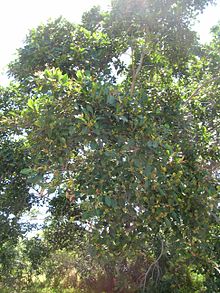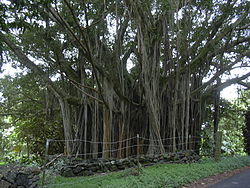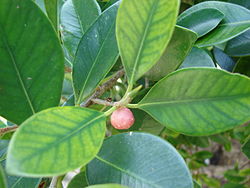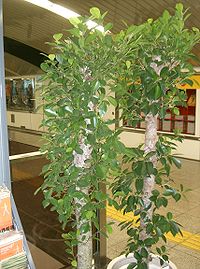- Ficus microcarpa
-
"Curtain fig" redirects here. For the Queensland, Australia strangler fig attraction, see Curtain Fig Tree.
Ficus microcarpa 
Scientific classification Kingdom: Plantae (unranked): Angiosperms (unranked): Eudicots (unranked): Rosids Order: Rosales Family: Moraceae Genus: Ficus Species: F. microcarpa Binomial name Ficus microcarpa
L.f.[1]Ficus microcarpa, also known as Chinese Banyan, Malayan Banyan, Indian Laurel or Curtain fig, is a banyan native in the range from Sri Lanka to India, southern China, the Malay Archipelago, the Ryukyu Islands, Australia, and New Caledonia.
Contents
Taxonomy
Hill's Weeping Fig is a form of Ficus microcarpa. It was first formally described as a species in its own right (Ficus hillii) by F.M. Bailey in the Botany Bulletin of the Queensland Department of Agriculture, based on the type specimen collected in the "scrubs of tropical Queensland'".[2] In 1960, it was reassigned by British botanist E.J.H. Corner as a variety of F. microcarpa, namely F. microcarpa var. hillii. In the 2005 Australian Plant Census it was treated as a synonym of F. microcarpa.[2]
Distribution and habitat
Ficus microcarpa was widely distributed as an ornamental plant and is one of the most common street trees in warm climates. The symbiotic pollinating fig wasp, Eupristina verticillata, was introduced along with F. microcarpa. Such an introduction, however, can be delayed: in Brazil - where specimens of the tree had been used in gardening since the nineteenth century, when it was introduced by the French architect Auguste François Marie Glaziou into various public parks of Rio de Janeiro - the appearance of saplings began only during the 1970s. Such saplings are considered to be very aggressive, as they can grow on the walls of buildings, bridges, highways, and other concrete structures.[3] The tree is considered a major invasive species in Hawaii, Florida, Bermuda, Central America, and South America.
Ecology
In some parts of its introduced range, it is very attractive to avian wildlife: in São Paulo, Brazil, ten species of birds were listed as feeding on its fruits, especially Turdus rufiventris, Pitangus sulphuratus, Turdus leucomelas, Thraupis sayaca and Celeus flavescens.[4] Its fruit and leaves are also sought after and eaten by the parrot Aratinga leucophthalmus.[5] Although invasive, its hardiness makes it an important species for the attraction of avian wildlife in urban environments.[6]
Cultivation
Ficus microcarpa is cultivated as an ornamental tree for planting in gardens, parks, and in containers as an indoor plant and bonsai specimen.
External links
- Plants of Hawaii: Ficus microcarpa, hear.org
- Ficus microcarpa L. f., Natural Resources Conservation Service of the U.S. Department of Agriculture
- Indian Laurel Invasive Plant Page, Bermuda Department of Conservation Services.
References
- ^ "Ficus microcarpa L.f.". Australian Plant Name Index (APNI), IBIS database. Centre for Plant Biodiversity Research, Australian Government. http://www.anbg.gov.au/cgi-bin/apni?taxon_id=37725.
- ^ a b "Ficus microcarpa var. hillii (F.M.Bailey) Corner". Australian Plant Name Index (APNI), IBIS database. Centre for Plant Biodiversity Research, Australian Government. http://www.anbg.gov.au/cgi-bin/apni?taxon_id=37747.
- ^ CARAUTA, Jorge Pedro Pereira & DIAZ, B. Ernani, Figueiras no Brasil, Rio de Janeiro, UFRJ, 2002, ISBN 85-7108-250-2, pg.155
- ^ Somenzari, Marina; Linda Lacerda da Silva; Rosanna G. Q. Benesi (2006). "Atração de aves por Ficus elastica Roxb. e Ficus microcarpa L. em ambiente urbano (abstract)". XIV Congresso Brasiliero de Ornitologia. http://www.ararajuba.org.br/sbo/cbo/xiv_cbo/Historia_natural.pdf.
- ^ da Silva, Linda Lacerda; Sonia Maria de Amorim Gimenez, Sumiko Namba (2006). "Método quantitativo para a avaliacão da preferência alimentar de Aratinga leucophthalmus em cativeiro (abstract)". XIV Congresso Brasiliero de Ornitologia. http://www.ararajuba.org.br/sbo/cbo/xiv_cbo/Comportamento.pdf.
- ^ Frisch, Johan Dalgas & Frisch, Christian Dalgas, Aves Brasileiras e Plantas que as Atraem, São Paulo:2005, ISBN 85-85015-07-1 , pg.366
Categories:- Ficus
- Trees of Asia
- Indomalaya flora
- Trees of China
- Trees of India
- Trees of Australia
- Flora of East Asia
- Flora of Southeast Asia
- Flora of Indochina
- Flora of Indomalesia
- Flora of Hong Kong
- Flora of Christmas Island
- Flora of the Ryukyu Islands
- Flora of Sri Lanka
- Flora of Australia
- Invasive plant species
- Invasive plant species in Hawaii
- Naturalized trees of Hawaii
- Garden plants of Asia
- Ornamental trees
- Plants used in bonsai
Wikimedia Foundation. 2010.



